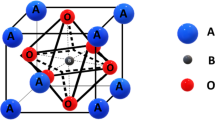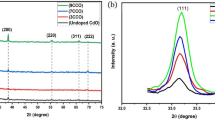Abstract
The structural and photoelectrochemical properties of mixed oxide semiconductor films of Bi-Nb-M-O (M = Al, Fe, Ga, In) were studied in order to explore their use as photoanodes in photoelectrochemical cells. These films were prepared on AISI/SAE 304 stainless steel plates by sol–gel dip-coating. The films were characterized by scanning electron microscopy—energy dispersive spectroscopy (SEM-EDS), X-ray diffraction (XRD), and X-ray photoelectron spectroscopy (XPS), and their photoelectrochemical properties were studied by open circuit potential (OCP) measurements, linear sweep voltammetry (LSV), and cyclic voltammetry (CV). SEM micrographs show homogeneous and rough films with agglomerates on the surface. EDS analyses show that the films are composed of Bi, Nb, and M, and the agglomerates are mainly composed of Bi. XRD analyses show a predominant crystalline phase of bismuth(III) oxide (Bi2O3) and a secondary phase composed of Bi-M mixed oxides. It is noteworthy that there was no identified niobium-based crystalline phase. XPS results reveal that the films are composed by Bi(III), Nb(V), and M(III). CV results show that the electrochemical behavior is attributed only to the semiconductor films which indicate a good coating of the stainless steel support. OCP measurements show that all the films have n-type semiconductor properties and exhibited photoresponse to the visible light irradiation. LSV results show that the application of a potential higher than +0.1 V enhances the photocurrent which can be attributed to an improved charge carrier separation. The results indicate that these materials can be used in photoelectrochemical cells.









Similar content being viewed by others
References
Fujishima A, Honda K (1972) Electrochemical photolysis of water at a semiconductor electrode. Nature 238:37–38
Aruchamy A, Aravamudan G, Subba Rao GV (1982) Semiconductor based photoelectrochemical cells for solar energy conversion—an overview. Bull Mater Sci 4:483–526
Tryk DA, Fujishima A, Honda K (2000) Recent topics in photoelectrochemistry: achievements and future prospects. Electrochim Acta 45:2363–2376
Grätzel M (2001) Photoelectrochemical cells. Nature 414:338–344
Zhang H, Chen G, Bahnemann DW (2009) Photoelectrocatalytic materials for environmental applications. J Mater Chem 19:5089–5121
Lianos P (2011) Production of electricity and hydrogen by photocatalytic degradation of organic wastes in a photoelectrochemical cell. J Hazard Mater 185:575–590
Ochiai T, Fujishima A (2012) Photoelectrochemical properties of TiO2 photocatalyst and its applications for environmental purification. J Photochem Photobiol C 13:247–262
Li Y, Zhang JZ (2009) Hydrogen generation from photoelectrochemical water splitting based on nanomaterials. Laser Photonics Rev 4:517–528
Navarro RM, del Valle F, Villoria de la Mano JA, Álvarez-Galván M, Fierro J (2009) Photocatalytic water splitting under visible light. Advances in chemical engineering. Elsevier, pp. 111–143
Georgieva J, Valova E, Armyanov S, Philippidis N, Poulios I, Sotiropoulos S (2012) Bi-component semiconductor oxide photoanodes for the photoelectrocatalytic oxidation of organic solutes and vapours: a short review with emphasis to TiO2–WO3 photoanodes. J Hazard Mater 211–212:30–46
Riboni F, Bettini LG, Bahnemann DW, Selli E (2013) WO3-TiO2 vs. TiO2 photocatalysts: effect of the W precursor and amount on the photocatalytic activity of mixed oxides. Catal Today 209:28–34
Bian Z, Zhu J, Wang S, Cao Y, Qian X, Li H (2008) Self-assembly of active Bi2O3/TiO2 visible photocatalyst with ordered mesoporous structure and highly crystallized anatase. J Phys Chem C 112:6258–6262
Xu J, Ao Y, Fu D, Yuan C (2008) Synthesis of Bi2O3-TiO2 composite film with high-photocatalytic activity under sunlight irradiation. Appl Surf Sci 255:2365–2369
Zhao X, Liu H, Qu J (2011) Photoelectrocatalytic degradation of organic contaminants at Bi2O3/TiO2 nanotube array electrode. Appl Surf Sci 257:4621–4624
Ohno T, Miyamoto Z, Nishijima K, Kanemitsu H, Xueyuan F (2006) Sensitization of photocatalytic activity of S- or N-doped TiO2 particles by adsorbing Fe3+ cations. Appl Catal A 302:62–68
Dholam R, Patel N, Adami M, Miotello A (2009) Hydrogen production by photocatalytic water-splitting using Cr- or Fe-doped TiO2 composite thin films photocatalyst. Int J Hydrog Energy 34:5337–5346
Di Paola A, García-López E, Marcì G, Palmisano L (2012) A survey of photocatalytic materials for environmental remediation. J Hazard Mater 211–212:3–29
Zhang L, Wang W, Yang J, Chen Z, Zhang W, Zhou L, Liu S (2006) Sonochemical synthesis of nanocrystallite Bi2O3 as a visible-light-driven photocatalyst. Appl Catal, A 308:105–110
Gao F, Chen XY, Yin KB, Dong S, Ren Z, Yuan F, Yu T, Zou Z, Liu J (2007) Visible-light photocatalytic properties of weak magnetic BiFeO3 nanoparticles. Adv Mater 19:2889–2892
Wang W, Li N, Chi Y, Li Y, Yan W, Li X, Shao C (2013) Electrospinning of magnetical bismuth ferrite nanofibers with photocatalytic activity. Ceram Int 39:3511–3518
Soltani T, Entezari MH (2013) Sono-synthesis of bismuth ferrite nanoparticles with high photocatalytic activity in degradation of rhodamine B under solar light irradiation. Chem Eng J 223:145–154
Wang X, Lin Y, Ding X, Jiang J (2011) Enhanced visible-light-response photocatalytic activity of bismuth ferrite nanoparticles. J Alloys Compd 509:6585–6588
Fang J, Ma J, Sun Y, Liu Z, Gao C (2011) Synthesis of Bi3NbO7 nanoparticles with a hollow structure and their photocatalytic activity under visible light. Solid State Sci 13:1649–1653
Zhang G, Yang J, Zhang S, Xiong Q, Huang B, Wang J, Gong W (2009) Preparation of nanosized Bi3NbO7 and its visible-light photocatalytic property. J Hazard Mater 172:986–992
Ai Z, Ho W, Lee S (2012) A stable single-crystal Bi3NbO7 nanoplates superstructure for effective visible-light-driven photocatalytic removal of nitric oxide. Appl Surf Sci 263:266–272
Wang L, Wang W, Shang M, Sun S, Yin W, Ren J, Zhou J (2010) Visible light responsive bismuth niobate photocatalyst: enhanced contaminant degradation and hydrogen generation. J Mater Chem 20:8405–8410
Lin X, Huang F, Wang W, Xia Y, Wang Y, Liu M, Shi J (2008) Photocatalytic activity of a sillenite-type material Bi25GaO39. Catal Commun 9:572–576
Zhang CY, Sun HJ, Chen W, Zhou J, Li B, Wang Y (2009) Hydrothermal synthesis and photo-catalytic property of Bi25FeO40 powders. Applications of Ferroelectrics. IEEE, pp 1–3
Zou Z, Ye J, Arakawa H (2000) Synthesis, magnetic and electrical transport properties of the Bi2InNbO7 compound. Solid State Commun 116:259–263
Zou Z, Ye J, Arakawa H (2001) Preparation, structural and optical properties of a new class of compounds, Bi2MNbO7 (M = Al, Ga, In). Mater Sci Eng B 79:83–85
Zou Z, Ye J, Arakawa H (2001) Substitution effects of In3+ by Fe3+ on photocatalytic and structural properties of Bi2InNbO7 photocatalysts. J Mol Catal A Chem 168:289–297
Zou Z, Ye J, Arakawa H (2003) Photocatalytic water splitting into H2 and/or O2 under UV and visible light irradiation with a semiconductor photocatalyst. Int J Hydrog Energy 28:663–669
Zou Z, Ye J, Arakawa H (2001) Photocatalytic and photophysical properties of a novel series of solid photocatalysts, Bi2MNbO7 (M=Al3+, Ga3+ and In3+). Chem Phys Lett 333:57–62
Zou Z, Ye J, Arakawa H (2001) Substitution effects of In 3+ by Al 3+ and Ga 3+ on the photocatalytic and structural properties of the Bi2InNbO7 photocatalyst. Chem Mater 13:1765–1769
Garza-Tovar LL, Torres-Martínez LM, Rodríguez DB, Gómez R, del Angel G (2006) Photocatalytic degradation of methylene blue on Bi2MNbO7 (M = Al, Fe, In, Sm) sol–gel catalysts. J Mol Catal A Chem 247:283–290
Teixeira Z, Otubo L, Gouveia RF, Alves OL (2010) Preparation and characterization of powders and thin films of Bi2AlNbO7 and Bi2InNbO7 pyrochlore oxides. Mater Chem Phys 124:552–557
Ropero-Vega JL, Rosas-Barrera KL, Pedraza-Avella JA, Laverde-Cataño DA, Pedraza-Rosas JE, Niño-Gómez ME (2010) Photophysical and photocatalytic properties of Bi2MNbO7 (M=Al, In, Ga, Fe) thin films prepared by dip-coating. Mater Sci Eng B 174:196–199
Rosas-Barrera KL, Ropero-Vega JL, Pedraza-Avella JA, Niño-Gómez ME, Pedraza-Rosas JE, Laverde-Cataño DA (2011) Photocatalytic degradation of methyl orange using Bi2MNbO7 (M=Al, Fe, Ga, In) semiconductor films on stainless steel. Catal Today 166:135–139
Pedraza-Avella JA, Rosas-Barrera KL, Pedraza-Rosas JE, Laverde-Cataño DA (2011) Photoelectrochemical hydrogen production from aqueous solution containing cyanide using Bi2MNbO7 (M=Al, Fe, Ga, In) films on stainless steel as photoanodes. Top Catal 54:244–249
Rosas-Barrera KL, Pedraza-Avella JA, Ballén-Gaitán BP, Cortés-Peña J, Pedraza-Rosas JE, Laverde-Cataño DA (2011) Photoelectrolytic hydrogen production using Bi2MNbO7 (M=Al, Ga) semiconductor film electrodes prepared by dip-coating. Mater Sci Eng B 176:1359–1363
Sokolov S, Ortel E, Radnik J, Kraehnert R (2009) Influence of steel composition and pre-treatment conditions on morphology and microstructure of TiO2 mesoporous layers produced by dip coating on steel substrates. Thin Solid Films 518:27–35
Iyyapushpam S, Nishanthi ST, Pathinettam Padiyan D (2013) Photocatalytic degradation of methyl orange using α-Bi2O3 prepared without surfactant. J Alloys Compd 563:104–107
Weidong H, Wei Q, Xiaohong W, Xianbo D, Long C, Zhaohua J (2007) The photocatalytic properties of bismuth oxide films prepared through the sol–gel method. Thin Solid Films 515:5362–5365
Brezesinski K, Ostermann R, Hartmann P, Perlich J, Brezesinski T (2010) Exceptional photocatalytic activity of ordered mesoporous β-Bi2O3 thin films and electrospun nanofiber mats. Chem Mater 22:3079–3085
Gurunathan K (2004) Photocatalytic hydrogen production using transition metal ions-doped γ-Bi2O3 semiconductor particles. Int J Hydrog Energy 29:933–940
Xia J, Masaki N, Jiang K, Yanagida S (2007) Sputtered Nb2O5 as a novel blocking layer at conducting glass/TiO2 interfaces in dye-sensitized ionic liquid solar cells. J Phys Chem C 111:8092–8097
Innocenzi P, Martucci A, Armelao L, Licoccia S, Di Vona M, Traversa E (2000) Sol–gel synthesis of β-Al2TiO5 thin films at low temperature. Chem Mater 12:517–524
Fujii T, De Groot FMF, Sawatzky GA, Voogt F, Hibma T, Okada K (1999) In situ XPS analysis of various iron oxide films grown by NO2-assisted molecular-beam epitaxy. Phys Rev B 59:3195–3202
Valet M, Hoffman DM (2001) Synthesis of homoleptic gallium alkoxide complexes and the chemical vapor deposition of gallium oxide films. Chem Mater 13:2135–2143
Poznyak SK, Kulak AI (2000) Characterization and photoelectrochemical properties of nanocrystalline In2O3 film electrodes. Electrochim Acta 45:1595–1605
Vivier V, Régis A, Sagon G, Nedelec J, Yu L, Cachet-Vivier C (2001) Cyclic voltammetry study of bismuth oxide Bi2O3 powder by means of a cavity microelectrode coupled with Raman microspectrometry. Electrochim Acta 46:907–914
Aroutiounian VM, Arakelyan VM, Shahnazaryan GE (2005) Metal oxide photoelectrodes for hydrogen generation using solar radiation-driven water splitting. Sol Energy 78:581–592
Lei C-X, Zhou H, Wang C, Feng Z-D (2013) Self-assembly of ordered mesoporous TiO2 thin films as photoanodes for cathodic protection of stainless steel. Electrochim Acta 87:245–249
Straka L, Yagodzinskyy Y, Kawakami H, Romu J, Ilola R, Hänninen H (2008) Open-circuit potential as an indicator of damage of atomic layer deposited TiO2 on AISI 304 stainless steel. Thin Solid Films 517:641–647
Memming R (1988) Photoelectrochemical solar energy conversion. In: Steckhan E (ed) Electrochemistry II. Springer, Berlin, pp 79–112
Xu Y, Schoonen MA (2000) The absolute energy positions of conduction and valence bands of selected semiconducting minerals. Am Mineral 85:543–556
De Tacconi NR, Chenthamarakshan CR, Yogeeswaran G, Watcharenwong A, de Zoysa R, Basit N, Rajeshwar K (2006) Nanoporous TiO2 and WO3 films by anodization of titanium and tungsten substrates: influence of process variables on morphology and photoelectrochemical response. J Phys Chem B 110:25347–25355
McShane CM, Choi K-S (2009) Photocurrent enhancement of n-type Cu2O electrodes achieved by controlling dendritic branching growth. J Am Chem Soc 131:2561–2569
Acknowledgments
This work has been carried out with the financial support of Universidad Industrial de Santander (DIEF Ciencias, Project 5185). J.L. Ropero-Vega thanks COLCIENCIAS for the doctoral scholarship in the frame of the program “Convocatoria nacional para estudios a nivel de doctorado en Colombia—año 2009”. The authors thank Jonathan I. Avila for the XPS analyses.
Author information
Authors and Affiliations
Corresponding author
Electronic supplementary material
Below is the link to the electronic supplementary material.
ESM 1
(PDF 1040 kb)
Rights and permissions
About this article
Cite this article
Ropero-Vega, J.L., Meléndez, A.M., Pedraza-Avella, J.A. et al. Mixed oxide semiconductors based on bismuth for photoelectrochemical applications. J Solid State Electrochem 18, 1963–1971 (2014). https://doi.org/10.1007/s10008-014-2420-4
Received:
Revised:
Accepted:
Published:
Issue Date:
DOI: https://doi.org/10.1007/s10008-014-2420-4




